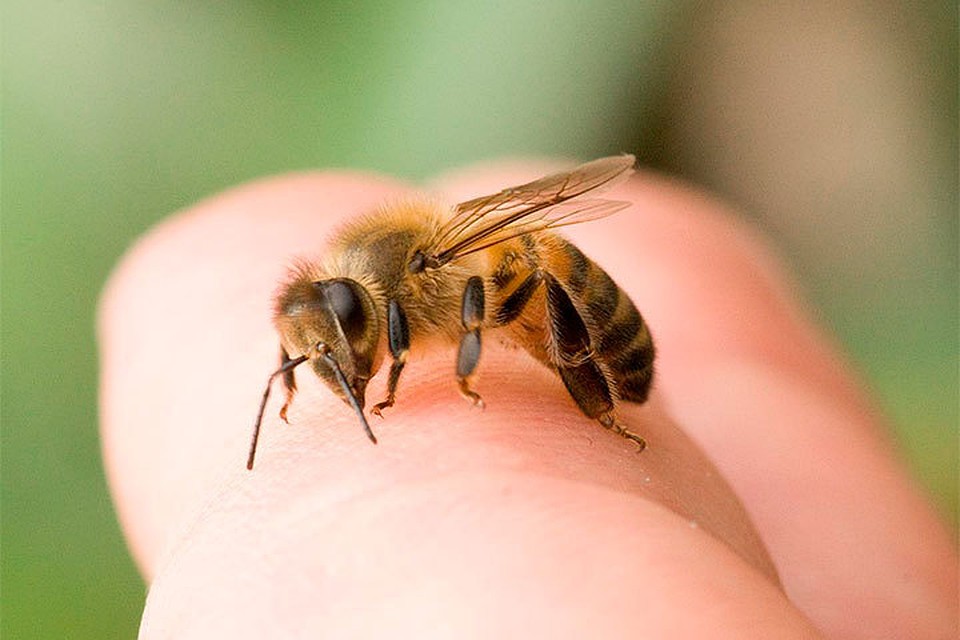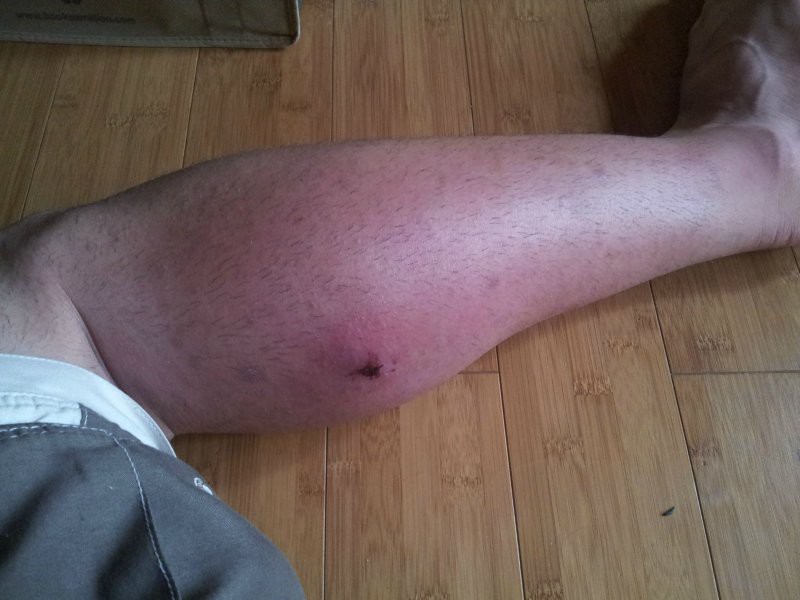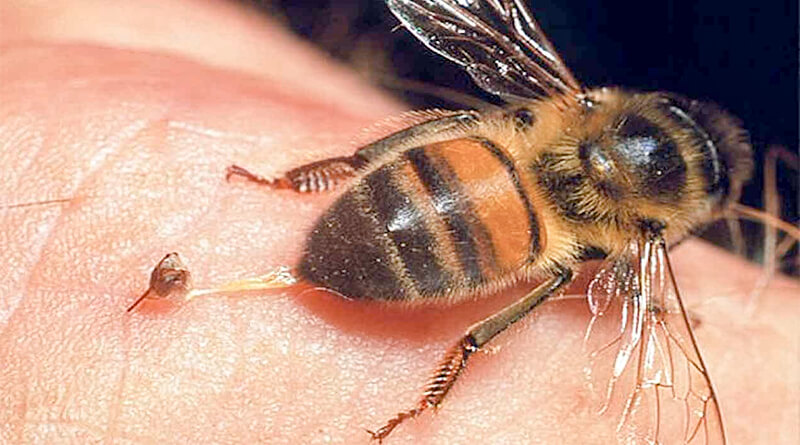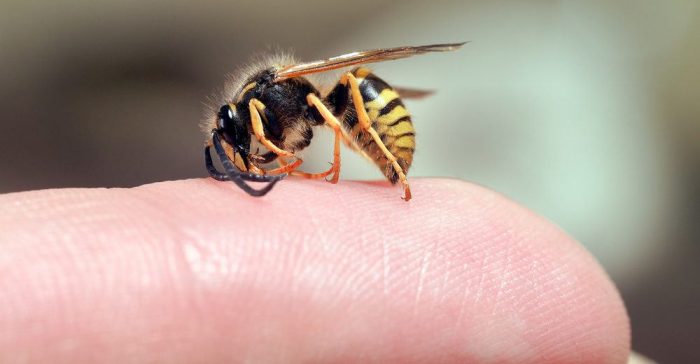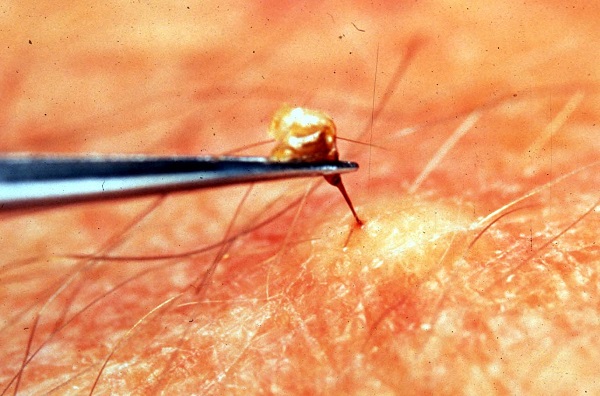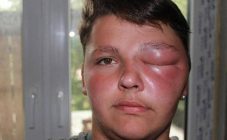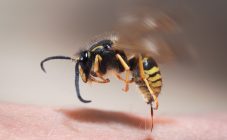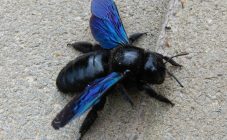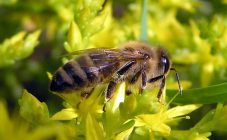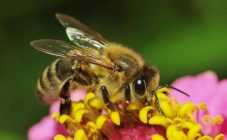Content:
Summer is considered a time of active recreation. But when walking in the fresh air and nature, dangerous situations are not uncommon. Very often in the summer, people suffer from the bites of various insects. Often, bees become the cause of pain and swelling, so each person, going to rest in the fresh air, should know what to do if a bee has bitten, how to remove the swelling. Indeed, it is at this time that insects begin to lead an active lifestyle: they collect nectar to provide food for their family in the coming winter.
Features of a bee sting
The peculiarity of bees is that they will not attack a person just like that. Most likely, before the attack, the insect considered danger and aggression in human behavior.
When bitten, a person feels a sharp, piercing pain. It manifests itself instantly, when the sting penetrates the skin. At this moment, a special poison gets under the dermis. The poisonous composition is at the tip of the needle. After the attack, the bee instantly dies, the person tries to get rid of the piercing pain for a long time. Together with the poison, a kind of substance enters the skin, which by nature resembles the communication hormones of these insects. Its scent will be a signal for other bees to attack the enemy.
Why does edema appear?
The appearance of edema in the area of the bite provokes special processes that occur after the sting enters the skin. On its edge is bee venom, which begins to spread under the dermis. The immune system instantly responds to the irritating factor, its cells accumulate in the affected area and begin to destroy the allergen. The result of these processes is the substance histamine. It is it that is deposited in tissues and provokes various allergenic reactions.
Allergic reaction to bites
Each person has their own unique reaction to a bee sting. According to the degree of difficulty, it can be divided into several groups:
- Strong;
- Moderate;
- Weak.
Each of the degrees of bite allergy has its own symptoms. With mild allergies, redness and an unpleasant burning sensation in the area of the bite are observed. The average degree is characterized by:
- Nausea;
- Slight swelling;
- Dizziness;
- Weakness.
The most severe is the strong form. When it is observed:
- Large swelling at the site of the bite;
- Vomiting;
- Bleeding;
- Lack of oxygen.
Why remove a sting after a bite
After a bee sting, most often a sting remains in the wound, which in an insect is associated with glands with a poisonous composition. It should be removed as quickly as possible, as it continues to release a toxic composition into the skin after a bite. It is best to remove it with tweezers, tweezers, or similar. If possible, removal is carried out so that the bag of poison located near the sting does not shrink.
How long do bite symptoms last
This period is individual for each person and depends on the initial reaction to the ingested poison and the correctness of the assistance. In some of the mildest cases, the tumor goes away in 1-2 days, in others, the duration of unpleasant symptoms remains up to a week. When faced with such moments as a bee sting, swelling and redness, what to do is not worth thinking about, it is important to act correctly. Indeed, how long the symptoms of a bite will last depends on the correct and quick help provided.
First aid after a bite
Going to nature or for a walk in the fresh air, you should know how to properly not only protect yourself from an insect bite, but also how to relieve swelling and pain from a bee sting.
If a bee sting has occurred, a number of measures should be taken:
- To prevent further penetration of the poison, it is important to remove the sting as quickly as possible. The tweezers or other tool that will be used for removal is first disinfected, for example in alcohol.
- The lesion is treated with a solution of soap. You can also use a weak solution of potassium permanganate or ammonia.
- Edema can be prevented by using dandelion juice, ice, or a cloth soaked in cold water.
If there are many bites, it is important to drink plenty of water. It will not be superfluous to take an antihistamine (Suprastin, Travisil).
Possible consequences
The bite itself is not as dangerous as the body's reaction to the ingested bee venom. With strong susceptibility, anaphylactic shock may even occur, a more frequent reaction is urticaria. Each person's allergy manifests itself differently, so action should be taken immediately. If not acted upon, the injured person may die.
Puffiness
If there is a lot of swelling in the area of the wound, you can try to remove it using compresses. These can be tampons soaked in cold water, in a solution of hydrogen peroxide or ammonia. Treatment for post-bite edema should include antihistamines and ointments.
Allergy
The main consequence of a bee sting is an allergic reaction. It can be of three degrees of severity:
- Chills appear, the temperature rises, urticaria is observed, or Quincke's edema begins to develop.
- The moderate severity of allergies, when there is a violation of the heart rhythm, significant swelling of the mucous membranes is noticeable, and intestinal spasms occur.
- The most dangerous stage is anaphylactic shock. Without prompt medical attention, a person can die.
Most often, treatment is carried out with Suprastin, which is taken 1 tablet 3 times a day.This drug will help to significantly reduce symptoms and speed up treatment.
Tumor
In addition to swelling, a bee sting is often accompanied by a tumor. The first step is to apply an ice pack to the swollen area. It is recommended to take Diphenylhydramine to relieve the swelling. But this drug has a side effect of drowsiness.
Bee sting in the leg or arm
These are the least dangerous parts of the body. The reaction and the degree of allegory in this case are individual. The result is severe swelling, the site of the bite itches. If a bee has bitten in the hand, what to do is said above: you need to remove the sting and try to remove the swelling with cold or special preparations.
Bites to the neck or head are considered the most dangerous, since if there is an allergy to bee venom, the likelihood of its more rapid development increases. In this part of the body there is a huge number of nerve endings, blood vessels, lymph nodes, which significantly enhances the symptoms.
How to remove swelling at home
It is not always possible to go to the hospital or use medications to cope with the effects of a bee sting. Therefore, you can use recipes that will help treat a bee sting at home.
First and foremost, it is important to remove the sting with tweezers or tweezers.
The first pain after a bite will help ease the lubrication of the wounded area with a swab dipped in a solution of ammonia or potassium permanganate. Drink more water or tea.
Using folk remedies
To alleviate the condition and relieve swelling, folk recipes can help, which can always be used when providing assistance to the victim, if it is not possible to use modern medications:
- Activated charcoal and aspirin. In a glass of water, dissolve one tablet of aspirin and activated carbon. In the resulting solution, a cotton swab is moistened and the bite site is treated. The tool helps relieve pain and swelling, since aspirin has analgesic properties, and charcoal is an excellent adsorbent.
- Broth of parsley and plantain. Each of the plants can be used separately, can be used together. Chop the greens and pour boiling water over. Then the resulting gruel is applied to the site of the bite. Parsley and plantain have analgesic and anti-inflammatory properties that help relieve pain and swelling.
- Onion juice. Onions have bactericidal properties. Juice is used to treat the bite site. The remedy helps to quickly relieve pain and reduce swelling. Instead of pain, a slight burning sensation remains.
- Aloe leaves. This plant has been known for its bactericidal properties for a long time. The peel is removed from the leaves and applied to a large swollen area. You can also use aloe juice diluted with water.
What not to do
Sometimes a person, by his rash actions, can aggravate his condition and increase the allergic reaction. Therefore, there are a number of actions that are unacceptable to be performed after a bee sting:
- The bite site should not be rubbed, this contributes to the spread of the poison over a larger area of the skin.
- Redness from a bite is not allowed to be treated with any means related to household chemicals. This can lead to increased allergies.
- Do not scratch the wound, as an infection can get into it. The wound may start to fester.
- When doctors prescribe hormonal ointments, the treatment should be carried out near the wound. When such funds enter the site of the bite, a burning sensation is observed, the wound itself heals more slowly.
- With serious consequences of bites, you cannot self-medicate. Antibiotics and antihistamines should be prescribed by a professional doctor.
How to prevent a bite
The first and most important piece of advice is immobility. This helps a lot. If bees are flying nearby, it is better to freeze. In no case should you wave your hands, this will anger the insects. Also, do not be afraid of panic, since the feeling of fear of a person increases the aggression of the bee.
You should be careful if you have a desire to eat sweets. It attracts insects. There is a danger that in general the bee will fall on the tongue.
Going to nature, you should choose clothes of calmer colors, bright things attract the attention of bees and become an annoying factor for them. It is also worth wearing clothes that cover open areas of the body as much as possible. It is equally important to make sure that insects do not get under clothing.
Bee stings cause a lot of inconvenience, some are even threatened with danger to life, therefore, if possible, contact with them should be avoided, not provoking or irritating insects. If, nevertheless, the bite has occurred, then first aid should be promptly and quickly provided to the victim.
